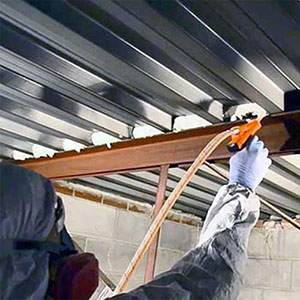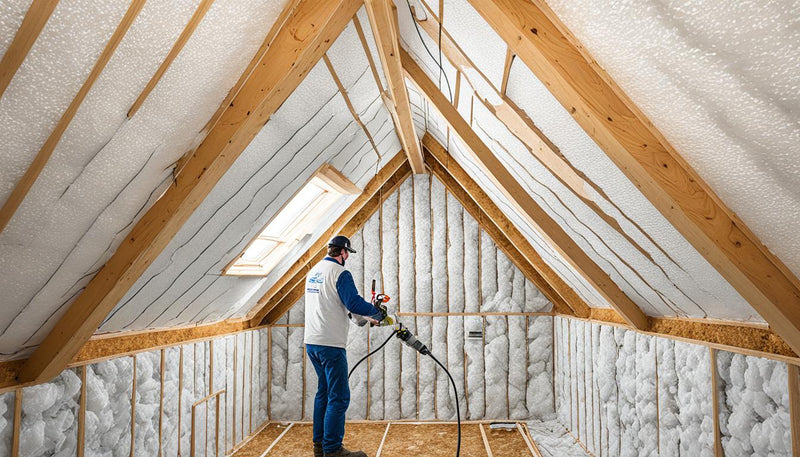The Process of Using Spray Foam: What You Required to Know
The Process of Using Spray Foam: What You Required to Know
Blog Article
Spray Foam: The Ultimate Solution for Air Sealing and Insulation
Spray foam insulation has emerged as a leading service for efficient air securing and thermal insulation, using an one-of-a-kind combination of residential or commercial properties that establish it apart from conventional approaches. Understanding the complete range of its benefits, installment procedures, and comparisons with various other insulation kinds is important for making notified choices.
What Is Spray Foam?
Spray foam is a functional insulation material that combines the concepts of air sealing and thermal resistance to boost power efficiency in structures. Composed primarily of polyurethane or various other similar substances, spray foam is applied as a fluid that broadens upon call with surface areas, creating a strong, continuous layer of insulation. This one-of-a-kind property permits it to fill voids, cracks, and gaps that standard insulation products may overlook, supplying a superior air seal.
There are 2 main kinds of spray foam: open-cell and closed-cell. Open-cell spray foam is lighter and much more adaptable, providing superb noise absorption and a reduced R-value per inch - Spray Foam. In contrast, closed-cell spray foam is denser, giving a higher R-value, wetness resistance, and included structural stability to building elements
The application process generally entails specific tools, making sure a seamless application that follows numerous substratums, consisting of concrete, timber, and steel. This adaptability makes spray foam suitable for both brand-new buildings and retrofitting existing structures. Its capability to develop an impermeable obstacle significantly adds to minimizing power usage and enhancing indoor air quality, thus making it a favored selection amongst property owners and builders alike.
Advantages of Spray Foam Insulation
One of one of the most considerable advantages of spray foam insulation is its exceptional ability to create a continuous air barrier, which effectively minimizes energy loss. Unlike traditional insulation materials, spray foam expands to load splits and spaces, making certain that air leak is significantly decreased. This characteristic not just boosts power performance yet additionally brings about decrease energy expenses in time.
Additionally, spray foam insulation offers superior thermal resistance, contributing to an extra secure indoor environment. Its high R-value per inch enables for efficient insulation in confined spaces, making it optimal for attics, walls, and crawl spaces. The moisture-resistant residential or commercial properties of spray foam assistance protect against mold and mildew and mold development, advertising much healthier living problems.
An additional crucial benefit of spray foam insulation is its sound-dampening top qualities (Spray Foam). It properly reduces noise transmission in between areas, creating a quieter and a lot more comfortable home setting. The longevity of spray foam also stands apart, as it does not sag or clear up over time, maintaining its efficiency throughout its life-span
Just How Spray Foam Functions
Understanding exactly how spray foam insulation works is important for valuing its efficiency in air sealing and thermal resistance. Spray foam insulation contains two key parts: isocyanate and polyol resin. When these components are mixed, they undertake a chain reaction that creates the material to broaden rapidly, producing a dense foam that fills up fractures, tooth cavities, and voids.
As the foam broadens, it follows surfaces, forming an impermeable seal that significantly decreases air Related Site seepage. This particular makes spray foam insulation very reliable at protecting against drafts and wetness infiltration, which can lead to power loss and damages with time. Furthermore, the closed-cell variation of spray foam supplies premium thermal resistance due to its rigid structure, successfully lessening warmth transfer.
The one-of-a-kind residential properties of spray foam permit it to adjust to uneven surface areas, making certain comprehensive coverage and a seamless obstacle. Therefore, spray foam insulation not just boosts power performance yet additionally adds to boosted interior air top quality by lowering the buildup of toxins and More Info irritants. Ultimately, recognizing the mechanics behind spray foam underscores its role as an exceptional option for insulation and air sealing in both household and industrial applications.
Installment Process Overview

Prior to installation, the area should be sufficiently cleaned and prepped, making certain that surfaces are without moisture, particles, and dust. Due to the fact that contaminants can compromise attachment and general efficiency, this action is vital. When the location is prepared, the application involves mixing the two components of the spray foam, which broadens upon contact and fills spaces successfully.
Educated professionals ought to carry out the setup, using specific equipment to guarantee uniform coverage and ideal thickness. Security safety measures, consisting of using protective gear and ensuring correct air flow, are essential during this procedure. After application, the foam commonly treatments promptly, developing a strong barrier that improves energy performance.
Contrasting Spray Foam to Typical Insulation
When reviewing insulation alternatives, spray foam insulation attracts attention in contrast to conventional materials such as fiberglass and cellulose. Among the main benefits of spray foam is its remarkable air sealing abilities. Unlike fiberglass and cellulose, which can enable air infiltration, spray foam broadens upon application, filling voids and gaps to create an airtight seal. This causes boosted power effectiveness, as less heated or cooled air escapes the home, leading to lower utility bills.
In addition, spray foam supplies a greater R-value per inch than typical insulation types, providing even more effective thermal resistance in a thinner profile. This characteristic is specifically advantageous precede with restricted cavity depth. Additionally, spray foam is immune to wetness and mold and mildew development, which can be a substantial worry about cellulose and fiberglass, especially in moist environments.
Nonetheless, spray foam insulation usually carries a greater ahead of time cost than its conventional counterparts. Homeowners should consider this initial investment versus long-term power savings and efficiency benefits. Inevitably, while both insulation kinds offer their purpose, spray foam arises as an advanced remedy for modern insulation requirements, particularly in regards to air sealing and thermal effectiveness.

Final Thought
In recap, spray foam insulation represents a very effective service for accomplishing optimum air securing and thermal resistance. Its unique buildings, consisting of wetness resistance and noise dampening, make it appropriate for different applications in both brand-new check out here buildings and retrofitting tasks (Spray Foam). Although the preliminary expenses may be higher compared to conventional insulation products, the long-lasting advantages, such as considerable power financial savings and enhanced indoor air quality, justify the financial investment and highlight its worth in contemporary structure techniques.
Spray foam insulation has actually emerged as a leading solution for efficient air sealing and thermal insulation, supplying a special combination of buildings that set it apart from traditional methods.Spray foam is a versatile insulation product that combines the concepts of air securing and thermal resistance to improve power effectiveness in structures.When assessing insulation alternatives, spray foam insulation stands out in comparison to standard materials such as fiberglass and cellulose. Eventually, while both insulation kinds serve their objective, spray foam emerges as a much more advanced option for modern insulation requirements, specifically in terms of air sealing and thermal effectiveness.
In recap, spray foam insulation represents an extremely reliable solution for accomplishing optimum air sealing and thermal resistance.
Report this page